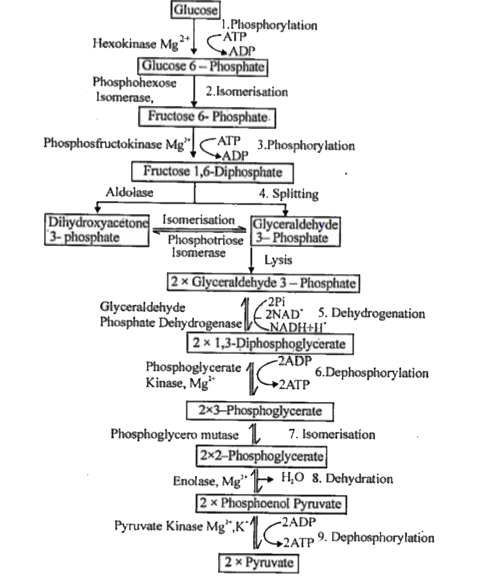Give schematic representation of glycolysis
Glycolysis is also known as Embden-Meyerhof pathway (EMP) or Embden-Meyerhof-Parnas pathway. It occurs in cytoplasm. The various steps involved in glycolysis are as follows:
i) Phosphorylation of Glucose : Glucose is converted into glucose 6-phosphate with the help of ATP. The reaction is carried out in the presence of enzyme hexokinase or glucokinase and Mg2+.
Glucose + ATP Mg2+Hexokinase−−−−−−−→Glucose 6-phosphate.
ii) Isomerisation : Glucose 6-phosphate is converted into its isomer fructose 6-phosphate. This reaction takes place in the presence of enzyme phosphoglucoisomerase.
Glucose-6 phosphate Phosphogluco<⇒Isomerase Mg2+Fructose 6-phosphate.
iii) Phosphorylation : Fructose 6-phosphate again phosphorylated by means of ATP in the presence of enzyme phosphofructokinase.
Fructose 1,6-diphosphate + ADP Phosphofructokinase<⇒Mg2Fructose 1,6-diphosphate + ADP.
Splitting : Fructose 1,6-diphosphate splits up into two 3-carbon compounds. These are glyceraldehyde 3- phosphate and dihydroxyacetone 3-phosphate. Dihydroxyacetone 3-phosphate is changed into glyceraldehyde 3-phosphate in the presence of enzyme phosphotrioseisomerase.
Fructose 1,6-diphosphate Aldolase<⇒Glyceraldehyde 3-phosphate + Dihydroxyacetone 3-phosphate.
Dihydroxyacetone 3-phosphate Triose Phosphates<⇒IsomeraseGlyceraldehyde 3-phosphate.

v) Dehydrogenation and Phosphorylation : Glyceraldehyde 3-phosphate looses hydrogen to NADto form NADH2 and use organic phosphate to form 1,3 diphosphoglycerate. The reaction is catalysed by enzyme glyceraldehyde phosphate dehydrogenase.
Glyceraldehyde Glyceraldehyde 3-Phosphate +H3PO4+NAD+Glyceraldehycle<⇒Phosphate dehydrogenase
vi) Formation of ATP: One phosphate borid of 1,3-disphosphoglycerate is linked by high energy bond and produces ATP in the presence of enzyme phosphoglycerate kinase.
1, 3.diphosphoglycerate Kinase+Mg2+ Phosphoglycerate3-Phosphoglyceratė + ATP.
vii) Isomerisation : 3-phosphoglycerate is changed to its isomer 2-phosphoglycerate in the presence of enzyme phosphoglyceromutase.
3 Phosphoglycerate. hosphoglycero<⇒Mutase2-phosphoglycerate
viii) Dehydration : 2-phosphoglycerate is changed into phosphoenol - pyruvate. The reaction is catalysed in the presence of enzyme enolase and cofactor Mg2+.
2-Phosphoglycerate Enolase<⇒ Phosphoenol pyruvate + H2O.
ix) Formation of ATP and Pyruvate : Phosphate bond of phosphoenol pyruvate carries higher amount of energy. It is transferred to ADP by enzyme pyruvate kinase, Mg2+ and K+. This produces ATP and Pyruvate.
Similar Questions
Give the schematic representation of glycolysis.
View SolutionGive the schematic representation of glycolysis?
View SolutionGive the schematic representation of glycolysis.
View SolutionGive schematic representation of cyclic photophosphorylation.
View SolutionWhat is oogenesis? Give schematic representation of oogenesis.
View SolutionGive schematic representation of classification of matter based on its composition.
View SolutionGive schematic representation of classification of matter based on its composition.
View SolutionGive a schematic repesentation of oogesis in humans . Mention the number of chhromosomes at each stage .Correlate the life phases of the individual with the stage of the process .
View SolutionGive schematic representation of carbon cycle.
View SolutionGive the schematic representation of linear polymers, branched chain polymer and cross intermolecular forces of elastomers and fibres.
View Solution
